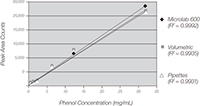Environmental Sample Preparation Using the Microlab 600 Is Accurate and Fast
Environmental laboratories analyze customer samples to determine the concentration of contaminants in soil, drinking water, and so on. Frequently these samples are diluted prior to analysis by the ICP-MS. It is critical that these dilutions are accurate and reproducible. In this study we compared the speed, accuracy, and consumable costs for common sample preparation techniques and found that the Microlab 600 is the best option.
Environmental laboratories analyze customer samples to determine the concentration of contaminants in soil, drinking water, and so on. Frequently these samples are diluted prior to analysis by the ICP-MS. It is critical that these dilutions are accurate and reproducible. In this study we compared the speed, accuracy, and consumable costs for common sample preparation techniques and found that the Microlab 600 is the best option.
Pipettes, volumetric glassware, syringes, and the Microlab 600 Diluter are commonly used to dilute environmental samples. Each of these techniques offers different advantages and disadvantages. Volumetric glassware is easy to use but dilution waste volumes are large and the glassware requires cleaning. Pipettes have small dilution volumes but the accuracy varies across different solvents. Additionally, the consumable plastic tip increases cost per sample and for some applications can leach contaminants. Syringes produce small dilution volumes and are inert, but manual operation and cleaning reduces throughput. The Microlab 600 has small dilution volumes, an inert fluid path, and is the fastest of the techniques.
Experimental Conditions
Each technique (volumetric glassware, pipettes, syringes, and the Microlab 600) was used to prepare dilutions of a standard stock solution. The samples were diluted to 1:1, 1:4, 1:9, 1:49, 1:99, and 1:199 in replicates of five. Each technique was performed one at a time. The samples were then analyzed and the data plotted to compare the accuracy of the different techniques.
Results
The results shown in Figure 1 show the dilution series for each technique along with a best fit line and an R2 value. All techniques showed a high correlation but the Microlab 600 was the highest with a value of 0.9992.

Conclusions
Each of the techniques yielded accurate dilutions with an aqueous stock solution. Of the four options tested the Microlab 600 consumed the least amount of sample and diluent, required no consumable pipette tips, and had an inert fluid path making it compatible with all tests performed in an environmental lab.
Additional head to head testing was performed between pipettes and the Microlab 600 using live samples at a local environmental lab. This testing showed that the Microlab 600 achieved a 40% reduction in processing time making it the clear choice for environmental sample preparation.

Hamilton Company
4970 Energy Way, Reno, NV 89502
tel. (775) 858-3000, fax (775) 856-7259
Website: www.hamiltoncompany.com

The Benefits of Custom Bonded Silica
April 1st 2025Not all chromatography resins are created equal. Off-the-shelf chromatography resins might not always meet the rigorous purification requirements of biopharmaceutical manufacturing. Custom bonded silica from Grace can address a wide range of separation challenges, leading to real performance improvements. Discover more about the latest innovations in chromatography silica from Grace, including VYDAC® and DAVISIL®.
5 Things to Consider When Selecting a Chromatography Silica
April 1st 2025Particularly in the pharmaceutical industry, drug purity isn’t just a goal – it’s essential for achieving safety, stability and efficacy. However, purification is easier said than done, especially with challenging molecules like DNA and RNA “oligonucleotides,” due in large part to their diversity and the range of impurities that can be generated during production. Enter DAVISIL® chromatographic silica, with a wide range of pore diameters and particle sizes to meet your specific application, performance and sustainability requirements. Before you choose the chromatography resin for your next purification application, take a look at these 5 considerations.
Automating Protein Purification: Efficiency, Yield, and Reproducibility
March 27th 2025Recent advancements in automated protein purification stress the importance of efficiency, scalability, and yield consistency. This eBook compares different purification platforms, highlighting their impact on downstream applications and demonstrating how automation enhances throughput and process control.
MilliporeSigma: Ultrapure Water for Sensitive LC-MS Analysis of Pesticides
March 25th 2025The aim of the study was to illustrate the efficiency of Milli-Q® water purification systems in eliminating pesticides from tap water, thereby producing and delivering reliable and consistent-quality ultrapure water suitable for pesticides analysis














